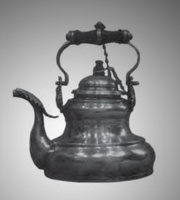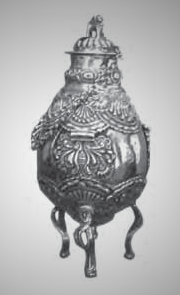-
Mate: Tied gourd, chiselled gold, golden chains Argentina, the first half of the 19th century - It Belonged to Incarnation Ezcurra of the Rosas - Cabbage. Horace Porcel and Ms.

-
Pava: Punch: C. R. - Molten Silver and chiselled Argentina; ends of the (XVIII) century - Cabbage. Carlos Hoss

-
Mate: Embossed, molten and chiselled silver High Peru, the second half of the 19th century Cabbage. Museum Fernandez Blanco.

Yerba Mate History
Is very difficult to come to a clinic, laboratory, field, chair or another place where veterinarians develop his activities without one offers us a mate. Then, how to separate the veterinarian of his consumption? But, a few know about his history and his legends! When in 1535 arrived Pedro of Mendoza to these coasts brings between his accompanists a soldier of the German infantry, Ulrico Schmiedl, who was the first chronicler of the conquest of this part of America. In 1536 it joins the expedition of Juan de Ayolas and Martinez de Irala to mend the Rio Parana with the purpose of coming to the Paraguay.
Impressed by the customs and the food of the Guarani Indians it describes them in his book " The conquest of the River Plate ", but it calls the attention that does not mention to the dull herb. Hernandarias, who was the first Creole who had a public post as governor of Asunción in 1544, observed that the Indians lIevaban a small bag of leather, purse where they were guarding the leaves of the dull bad herb to which called ca´a. They were chewing or doing this one an infusion that bebian in a gourd or "matí" with a chunk of cane tacuata. Between the legends, it reports the custom of the Indians of eating up occasionally some prisoner, whom before they were feeding and were cooking it with sweet-potatoes. It will be true?
In 1565, it begins the evangelization with Jesus´s Company, who establishes the first indigenous reduction in what it is today Missions, of that there stay still today ruins of extraordinary artistic and historical value. At his arrival the Jesuits prohibited it for considering it to be a vice, but then they stimulated it not only to avoid the consumption of alcohol to which they were be so fond the Indians but they saw in her an important source of income. Already at the beginning of the 17th century his culture was perfected and was the first product who sent, not only to the rest of the provinces, but also Spain where, to compete with the tea Englishman, it was selling like " You of the Jesuits ".
When in 1767 Carlos III of Spain expels them, the national output gets lost with them. Between 1779 and 1804 there comes to these lands the doctor and naturalist of the French sea-coast Bompland, whose real name was Aime Goujand, to take part of the expedition of the eminent German Alexander von Humbold, and together they describe more than 60.000 vegetable species and great quantity of insects and birds. In 1823 he is the French naturalist Augusto de Saint Hilaire who classifies it with his scientific name " lIex paraguariensis ". Bompland returns to America in 1816 got enthusiastic with the dull herb yen 1821 establishes itself in what is today the province of Missions. It requests permission the government of the Paraguay to be internalized of his culture but the dictator Rodriguez, before the dread of losing his monopoly, catches it. They control Simon Bolivar, von Humbold and the French government and after almost 10 years it is liberated.
In 1881 five German families settle down in San Bernardino forming the first colony for his exploitation and Ie follow others, between them the questioned New Slang, of the marriage Foster, the Berlin teacher and she Elizabeth Nietzsche, sister of the famous philosopher admired by Hitler together with the musician Wagner. In 1896 an investigator of this colony, Federico Neumann, compiling the technologies of the Indians and of the Jesuits, achieves his rational culture.
Us another question arises. How us IIega the mate from his place of origin? The Indians, on having moved back the Jesuits emigrate to the fields of the south and there they coexist with crafty and Spanish deserters of the realistic forces, trasmitiendo the tradition of the mate. About 1911 there expands really, so much that in 1935 dictates the law N° 12236 to regulate his culture and trade and imposing a tax to his explotation, of which it was liberated in 1957.
The legends are great on his origin, in Guarani and Christian versions. The first Ie attributes to Yari, the moon and Arai the pink cloud of the twilight, which went down to the forests that Tupá, powerful God of the Guarani ones, had created, being considering Ca&-yarí to be today his protective goddess. The Christian legends are great. Someone says that he was Jesus in company of San Juan and San Pedro that they lowered to the land to deliver it to the Guarani ones and another Ie attributes Saint Take. If some colleague is interested in knowing them we will put to his disposition the pertinent bibliography.
It could not be absent in the tango so established to our traditions. Enrique Santos Discepolo gives us a reflection of those bad times in Yira yira with "the yesterday herb drying off to the Sun", and some of the most former colleagues will resemble Lily Maizani in the ranchera " Bitter mate ". To feed a mate to a friend is much more than a social act. AI to stretch it with the hand is a real delivery of friendship and confidence.
Source: http://www.medvet.com.ar


